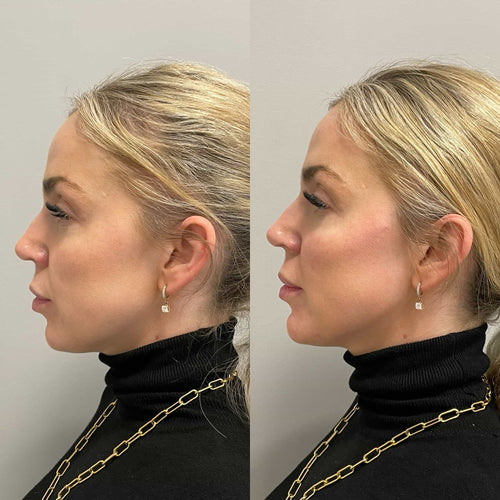Schedule Your Dermal Filler Appointment with Dr. Laura Geige Today
Understanding Your Skin’s Journey
Maturity of Skin
Schedule a Dermal Filler Consultation with Dr. Laura Geige
Understanding your skin’s journey and its natural maturation process is crucial when considering cosmetic procedures like dermal fillers.
Our skin undergoes significant changes throughout life, influenced by genetics, lifestyle, and environmental factors.
During our youth, collagen and elastin production is high, giving the skin its firmness and elasticity. As we age, this production naturally declines, leading to the visible signs of aging: fine lines, wrinkles, volume loss, and sagging.
Different individuals experience these changes at varying rates.
Some factors that accelerate skin aging include excessive sun exposure, smoking, poor diet, and dehydration.
It’s important to remember that aging is a natural process, and there is no “right” age to start considering fillers.
However, understanding your skin’s current state and its individual trajectory can help you make informed decisions about when and if fillers are right for you.
Consulting with a qualified dermatologist or plastic surgeon is essential for personalized advice.
They can assess your skin type, concerns, and desired outcomes to determine the most appropriate treatment plan.
Remember, the goal of cosmetic procedures like fillers is not to achieve artificial youthfulness but rather to enhance your natural beauty and restore a more youthful appearance.
Focusing on overall skin health through sun protection, hydration, a balanced diet, and proper skincare can complement any aesthetic treatments.
Factors Influencing Filler Suitability

Understanding your skin’s journey is essential before considering any aesthetic treatments, including dermal fillers. Skin undergoes natural changes throughout life due to factors like genetics, sun exposure, and collagen production decline. These changes manifest as wrinkles, loss of volume, and thinning.
While there’s no one-size-fits-all answer to when someone should get fillers, becoming aware of these skin transformations can help guide your decisions. Early 30s often mark the beginning of visible signs of aging for many people, with fine lines around the eyes and mouth becoming more prominent.
During this stage, preventative measures like sun protection and a healthy lifestyle play a crucial role in maintaining skin health. However, some individuals might opt for subtle filler treatments to address specific concerns, such as enhancing lip volume or smoothing out early frown lines.
As we age into our 40s and beyond, collagen loss accelerates, leading to deeper wrinkles and more pronounced volume loss in areas like the cheeks and jawline. Fillers can become increasingly beneficial at this stage for restoring lost volume, plumping up skin, and creating a more youthful appearance.

The suitability of fillers depends on several factors, including:
• **Individual Skin Health:** The condition of your skin, its elasticity, and thickness influence filler integration and longevity.
• **Desired Aesthetic Outcome:** What are your specific goals? Do you want to enhance lip fullness, smooth wrinkles, or restore facial volume?
• **Facial Anatomy:** Different fillers are designed for specific areas and skin types. Your provider will assess your unique features to determine the best options.
• **Medical History:** Certain medical conditions or allergies may affect filler suitability. It’s crucial to disclose all relevant information to your provider.
• **Lifestyle Factors:** Sun exposure, smoking, and hydration levels can impact filler results. Maintaining a healthy lifestyle can help maximize their effectiveness.
Consulting with a qualified and experienced aesthetic provider is essential for determining the right age to consider fillers and ensuring safe and effective treatments tailored to your individual needs.
Consultation is Key
Finding the Right Provider
Deciding when to explore cosmetic enhancements like dermal fillers is a deeply personal journey, and consultation is absolutely key to making an informed and confident decision.
Finding the right provider for your needs is paramount. Look for board-certified plastic surgeons or dermatologists with extensive experience in facial aesthetics and a strong understanding of facial anatomy.
During your consultation, be open and honest about your goals, concerns, and expectations. A skilled provider will listen attentively, assess your unique features, discuss potential risks and benefits, and guide you towards realistic outcomes.
Don’t hesitate to ask questions about the types of fillers available, their longevity, expected results, and aftercare instructions. It’s crucial to understand the procedure thoroughly before making any decisions.
Remember, age is just one factor to consider. Your skin’s health, lifestyle, and individual preferences all play a role in determining the right time for fillers.
A reputable provider will emphasize your natural beauty while helping you achieve subtle enhancements that complement your features and boost your confidence.
Secure a Dermal Filler Appointment with Dr. Laura Geige Today
Realistic Expectations
Consultation is absolutely key when considering any cosmetic procedure, especially dermal fillers. It’s not just about finding a qualified injector; it’s about building trust and ensuring your goals align with realistic expectations.
A good consultation will involve a thorough discussion of your desired outcome, medical history, and current skin condition. The injector should carefully evaluate your facial anatomy to determine which areas are best suited for fillers, the appropriate type of filler, and the optimal volume needed to achieve natural-looking results.
Realistic expectations are paramount when it comes to fillers. Remember, they don’t offer a complete makeover; rather, they enhance what you already have. It’s important to understand that fillers can smooth lines, add volume, and improve facial contours, but they won’t completely eliminate wrinkles or drastically alter your appearance.
Openly discuss your expectations with the injector during the consultation. Share any concerns you may have, including potential side effects. A skilled injector will provide honest feedback and help you set achievable goals. They should also explain the recovery process, expected results, and the duration of the effects.
Ultimately, choosing the right age to get fillers is a personal decision. It’s about feeling confident and comfortable with your appearance. But by prioritizing consultation and realistic expectations, you can make an informed choice that leads to a safe and satisfying outcome.
Long-Term Considerations
Maintenance and Longevity
Long-term considerations for facial fillers go beyond just the immediate aesthetic enhancement. It’s essential to understand that fillers are not permanent solutions, and their effects gradually diminish over time.
Maintenance involves regular touch-up appointments, typically every six months to a year, depending on the type of filler used and individual factors like skin elasticity and lifestyle.
The longevity of fillers varies widely. Hyaluronic acid fillers, which are commonly used, can last anywhere from 6 months to 2 years.
Other types, like poly-L-lactic acid, stimulate collagen production and can provide results that last up to several years.
Choosing a reputable injector who uses high-quality products and follows proper techniques is crucial for achieving optimal and lasting results.
Potential side effects, such as bruising, swelling, and tenderness, are generally temporary. However, in some cases, complications like infection or vascular occlusion can occur.
Therefore, it’s important to have realistic expectations about the duration of results and discuss potential risks and benefits thoroughly with a qualified medical professional before undergoing any filler treatment.
Potential Risks and Side Effects
Long-term considerations for dermal filler use include potential changes in skin texture, volume, and facial structure over time.
Here are some potential risks and side effects associated with long-term filler use:
-
Lumpiness or Nodules: The fillers can sometimes form hard lumps or nodules under the skin, which may require additional treatment to correct.
-
Asymmetry or Unevenness: If the filler is not injected evenly, it can lead to asymmetry in facial features.
-
Vascular Compromise: In rare cases, fillers can block blood vessels, leading to tissue damage or even necrosis (death of tissue). This is a serious risk that requires immediate medical attention.
-
Infection: As with any injection procedure, there is a risk of infection at the injection site.
-
Migration: Fillers can sometimes migrate from the injected area to adjacent tissues, causing unwanted swelling or distortion.
-
Allergic Reaction: Some individuals may have an allergic reaction to the filler material.
It’s important to consult with a qualified and experienced injector who can assess your individual needs and risks. Regular follow-up appointments are essential to monitor the results of the treatment and address any potential complications.
Long-term effects may vary depending on the type of filler used, the injection technique, and individual factors such as skin elasticity and metabolism.
Decléor Direct Mind Plus Motion Humboldt Apothecary CBD Kindra Mann Yummalicious Food
- Why Cant You Vape After Lip Filler - November 21, 2025
- What Is The Best Filler For Neck Lines? - November 19, 2025
- What Are The Benefits Of Bum Filler Injections? - November 17, 2025
